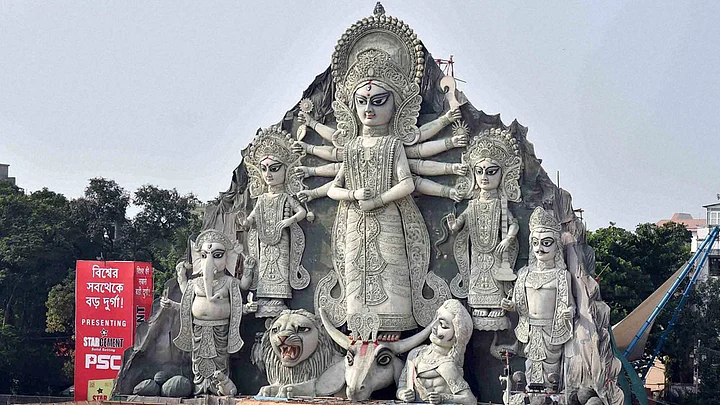Durga Puja is upon us – well at least upon all Bengalis, wherever they are on the planet – and Deshapriya Park, in south Calcutta, boasted about erecting the largest idol of the Mother Goddess on Earth.
What organisers and Kolkata Police did not reckon was the peripatetic Bengalis’ craze for novelty – especially when it came to Durga Puja – Bengal’s biggest annual festival. So, things spun out of control on October 17 and 18, before the real puja could begin on October 20, called ‘shaptami’ the seventh day of an auspicious lunar cycle.
Inside the Park, a stampede was narrowly avoided and though not many bones were finally broken, a blame game broke out between the cops and organisers.
Delving Into Durga Puja’s History
- Making of the Durga idol is the most intriguing of all the rituals
- The idol is fashioned from 18 different types of soil, including that collected from a brothel entrance and from a ‘four-cornered crossing’
- The roots of nearly all Mother Goddesses were ancient and probably pre-dated the Aryans
- Research suggests early female goddesses were saviours of traders and merchantmen, tinkers and tailors
- At the crossroads they worshipped female deities that were not, then, part of any established pantheon
Tales around the Puja
But even without these theatrics it’s clear that from 1606, when Bhabananda Majumdar of Nadia is recorded to have first worshipped the goddess, Durga Puja has an enduring place in the hearts – and wallets – of Bengalis.
Going by the book, the worship of Durga is a tough, demanding and extremely costly exercise. The costs involved are so heavy that till the 19th century only Bengal’s zamindars and affluent ‘native’ officials of the East India Company could afford to worship the Devi.
Gobindaram Mitra, among the first ‘black zamindars’ to be appointed by the Company in the 18th century used a solid silver throne to seat Durga, with smaller seats for her two sons, Ganesh and Kartik. Lakshmi and Saraswati were assigned marginal roles, off to each side of their mother. Shiva, the father, towered over all.
Given the excesses of zamindari culture, there are hilarious tales about the revelry surrounding the puja. One zamindar, completely drunk, spotted the lion, Durga’s vahan, under the foot of the idol. Claiming that there was no bigger lion in the neighbourhood than himself, this gentleman had the lion removed and sprawled in its place, only to wake up next morning hung-over and shame-faced.
The list of rituals associated with the puja would fill a hefty book: the Devi’s mahasnan or bathing rite alone consists of 75 separate ingredients. But the most intriguing part is the making of the idol itself.
Soil Steeped in Virtue
As every artisan from Kumortuli, where the images are made, will tell you, the idol of Durga has to be fashioned from 18 different types of soil. These include clay from an ant-hill and a mountain; soil from both sides of a river, soil from the door of a temple and a palace; that dug up by the tusk of a boar, an ox and an elephant.
But most intriguing perhaps are two types of soil that are essential: that collected from the entrance of a brothel and from a ‘four-cornered crossing.’
The rationale for collecting soil from a prostitute’s door has an endearingly folksy explanation. It’s said that men leave their virtues behind when they cross the threshold of a brothel. All this residual virtue accumulates over the course of the year, till the worship of Durga comes rolling around, when it is scooped up and used to make the idol.
Scooping up soil from brothel gates is not a simple matter. Every year, Kolkata’s old red-light district of Sonagachhi is witness to animated – and often ill-tempered – wrangling between brothel-keepers and idol-makers to set the right price for a handful of dust steeped in virtue.
It is harder to explain why it is necessary to gather dust from a ‘four-point crossing.’ For ages this was taken at face value and people went through the motions of collecting soil from such crossings. But the roots of this apparently simple thing, as historian Damodar Dharmanarayan Kosambi showed in his path-breaking works in the 1950s, go much deeper.
Historian Kosambi’s Research
Analysing passages from the Puranic texts, Kosambi stumbled upon repeated references to these ‘crossings.’ At some crossings, the wealthy were asked to sacrifice cows and distribute their parts to the less privileged; at others, he found references to female deities like Amba.
Further research allowed Kosambi to establish that the roots of nearly all Mother Goddesses worshipped across the country were ancient and probably pre-dated the Aryans, who only worshipped male deities. These early female goddesses were saviours of traders and merchantmen, tinkers and tailors who travelled those ancient highways.
At the crossroads where they stopped to rest, they began worshipping female deities that were not, then, part of any established pantheon. These were local goddesses often derived from animistic, life- or companionship-giving sources.
From those ancient epochs, shrouded in the haze of antiquity, comes the living tradition that mandates soil from crossings to be, literally, built into the image of Durga. Over time, this image has assumed so much charisma and inspired so much devotion, that it has subsumed many other female deities in its fold.
Thus Durga, who might have originated as a totem worshipped by ancient travellers by the roadside, is now known by at least 128 names in Bangla. Each describes an attribute, or aspect, of this Mother Goddess. Each probably had an independent existence somewhere, sometime, long, long ago.
(The writer is a Delhi-based senior journalist)
